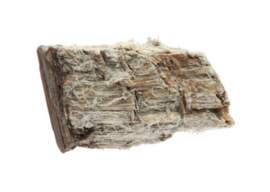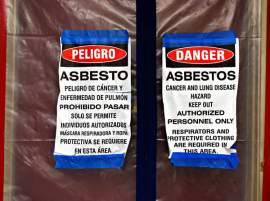
Occupational Exposure

Must Read
What is Asbestos? Asbestos is a naturally occurring fiber that was commonly used as a construction material because of its heat-resistant properties. Because of its heat resistant properties and fiber strength, asbestos has been used to manufacture goods, such as, paper products, floor tiles, shingles, automobile brakes, friction products, packaging, gaskets and coatings. Although harmless when untouched, asbestos fibers are extraordinarily toxic when asbestos-based products are contacted; when any asbestos-containing product is disturbed-- whether by remodeling, repair or demolition activities—the fibers are susceptible to becoming airborne. When these airborne materials are inhaled they will stick to the lungs, and overtime, cancerous tumors or other significant health problems may arise. Occupational Exposure to Asbestos: According to the National Institute for Occupational Health and Safety, more than 100 occupational organizations are known to expose workers to asbestos. The effect of occupational exposure to asbestos over the span of a working career has led many employees to develop mesothelioma cancer, asbestosis or other related diseases. Studies have shown that approximately half of the workers who are occupational exposed to asbestos fibers between 1930 and 1970 are currently living with an asbestos-related cancer. Asbestos fibers are almost omnipresent in the United States. Because of this ubiquity, asbestos was commonly incorporated into thousands of commercial, construction and household products including concrete, cement, retardant coatings, gaskets, insulation, drywall, flooring, joint compounds, sealants and paints. Asbestos also exists in plastics, electrical appliances, factories, schools, roads, ships, automobiles and trains. The most dangerous profession, with regards to asbestos exposure (those occupations with the greatest potential for perpetual asbestos exposure) is mining. Although the fiber is no longer mined in the United States, many American miners, over the course of decades, have contracted mesothelioma cancer, lung cancer and asbestosis. Following the mining profession, asbestos exposure is common in traditional industries where workers labor in close quarters in atmospheres with asbestos fibers. According to the National Institute for Occupational Safety and Health, approximately one-quarter of worker deaths caused by asbestos exposure in the 1990’s were employed in the construction industries. As a result, the second most dangerous industry with regards to contracting asbestos-related diseases is the construction industry. Following construction and mining, the next most hazardous industries are: • Industrial and chemicals • Railroads • Boat and ship building and repairing • General government jobs • Electrical power and light industries • Blast furnaces, finishing mills, rolling and steelworks • Elementary and secondary schools Occupations that are most frequently exposed to asbestos include the following: • Powerhouse workers • Painters • Floor Coverers • Refinery workers • Tile setters • Paper mill workers • Machinists • Protective clothing manufacturers • Packing and Gasket Manufacturing Workers • Tinsmiths • Weavers • Sawyers • Mixing Operatives • Warehouse workers • Excavators • Technicians Workers in other industries who do not handle asbestos directly, but who are exposed to it because the fibers were either in the atmosphere or in the products with which they contact include the following: • Paper and Glass Factory Workers • Textile Workers • Building Engineers • Aerospace Workers • Road Builders • Building Inspectors • Automobile Mechanics • Die Setter • Contractors and Building Managers


















